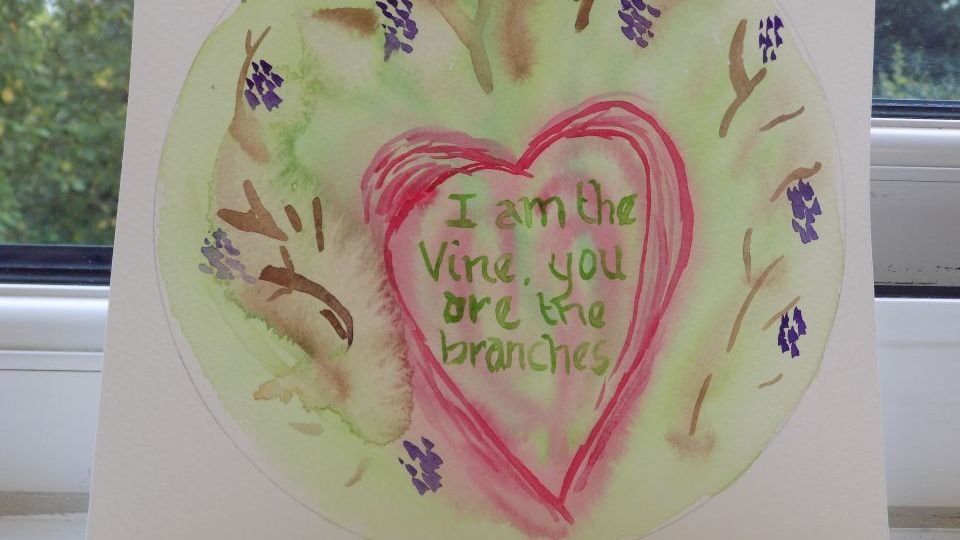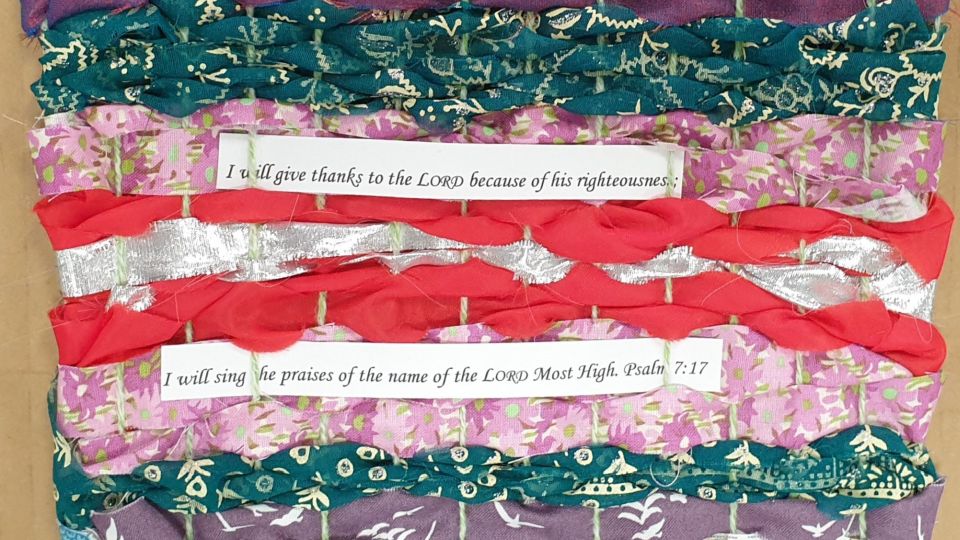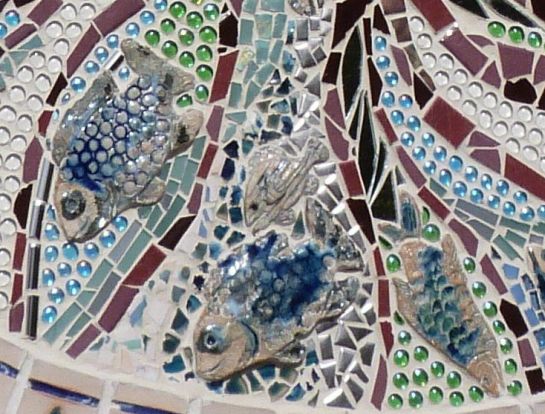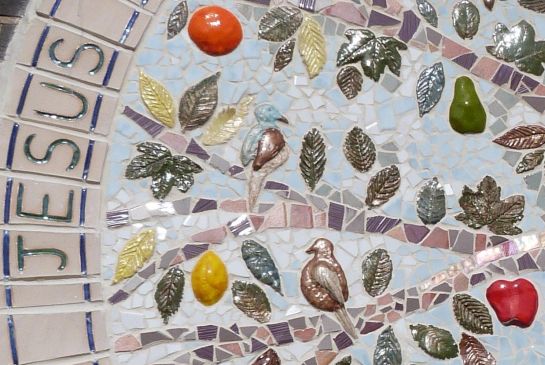
Many people have worked together to create a very special mosaic at Christ Church in Orpington, Kent.
It has taken seven months to bring this wonderful artwork to fruition. The mosaic, commissioned to mark the 75th anniversary of the church, was carried out by the whole church community led by artists Jo Colwill and Caroline Bailey. This is Caroline Bailey's account of the project.
A new mosaic to celebrate our 75th anniversary
If you walk past Christ Church Orpington on Charterhouse Road, or drive down Malvern Road, you may have noticed a new mosaic slowly emerging over the last month. You may also have noticed some precarious balancing on ladders and lengthy grouting and polishing by the team involved in making the piece! The image is of the ‘tree of life’ – a tree full of leaves with twelve fruit, with its roots going down into water which is teeming with fish. Birds are flying towards the tree and perching in its branches, and the circular piece is surrounded by a quote from the tenth verse of the tenth chapter of John’s Gospel – the text which titles this article. At the heart of the tree is a cross in iridescent bronze and purple tiles.
The mosaic was commissioned to mark the 75th anniversary of the church, which was celebrated from June 2014 to June 2015. The community art project was led and managed by Jo Colwill and Caroline Bailey who have worked on many mosaics in primary schools in Bromley Borough as well as at Bromley Baptist Church.
The journey from choosing a theme and drawing up the design to seeing the finished piece on the wall sparkling in the light has taken seven months, and many different people’s involvement to bring to fruition. But why this image? And why a community mosaic? Let’s start by unpacking the significance and inspiration of the image.
Design concept: Biblical inspiration
The Tree of Life image is a potent one found in many cultures. By drawing on a universal image, which we find used right through Scripture, and by placing the cross as the centre of this image, we speak of our God of love and sacrifice, who wants to grow His Kingdom as a place of life, growth and fruitfulness where there is a welcome for all.
Key texts from the Bible were drawn upon as inspiration for the ‘Tree of Life’:
-
Genesis 2: 9,10 describes the tree of life in the Garden of Eden (not to be confused with the ‘tree of knowledge of good and evil’ which Eve was tempted to eat from).
-
Psalm 1: 3 speaks of those who delight in God’s law as being like ‘trees planted by streams of water, which yield their fruit in season and whose leaves do not wither’.
-
Proverbs 3: 18 writes of ‘Wisdom’ as ‘a tree of life to those who embrace her’.
-
Jeremiah 17: 7, 8 tells us that ‘blessed are those who trust in the Lord … they will be like a tree planted by the water that sends out its roots by the stream. It does not fear when heat comes; its leaves are always green. It has no worries in a year of drought and never fails to bear fruit’.
-
Ezekiel 17: 23 describes a tree that ‘will produce branches and bear fruit … birds of every kind will nest in it; they will find shelter in the shade of its branches’.
-
Ezekiel 47: 7–9 goes on to speak of the river from the temple, which contains fresh water where everything will live, describing the many kinds of fish which swim there. The passage continues to tell of fruit trees of all kinds growing on both banks of the river, whose leaves do not wither nor whose fruit fail; they fruit every month and their fruit is for food and their leaves for healing.
-
Matthew 13: 31–32 relates Jesus’ parable of the mustard seed: a picture of the growth and life of God’s Kingdom being like a tiny seed growing to become a great tree for birds to make their home.
-
Revelation 22: 1–2 speaks of the ‘river of the water of life … on each side of the river stood the tree of life, bearing twelve crops of fruit, yielding its fruit every month. And the leaves of the tree are for the healing of the nations.’
This wonderful image of life which traces right through the Bible has been shown in the mosaic as an image of a single tree held within Jesus’ words: ‘I have come to bring life; life in all its fullness’. At the centre of the tree shines a cross, highlighting the central message of Christianity – that Christ lived, died and was raised again to life, that we may have eternal life in Him – this is the message of hope and life we hold out to one another.
Why a community mosaic?
The concept of the process of this piece was to combine the skills and talents of artists to create individual pieces to form elements of the design, and then widen out the project so that everyone could be involved. Having designed the piece, a workshop day was run to create clay originals and plaster moulds for the leaves, fruit, birds and fish. Ceramic pieces were then made in the moulds during our Community Fete day and over a Women’s Retreat weekend involving many people both from the church and local community. The tiles for the text were handmade by Caroline and Jo. The pieces were fired, glazed and re-fired over the summer ready for assembling into the mosaic in September 2014 on our Creative Arts Day to combine with broken glass and ceramic tiles to form the final piece.
From forming the clay pieces to mixing and pouring plaster, from much sprinkling of talcum powder to stop the clay sticking in the moulds to learning how to glaze, from driving to and from the Bromley Adult Education Centre for firings to rummaging in the vicarage garage for suitable tiles, from cutting tiny tiles to splitting a glass nugget in half or shaping a mirrored tile into a pleasing flash of silver to glint in the water … many hands have indeed made light work. The involvement of so many people has been a joy and delight as we have worked, laughed, chatted, concentrated and finally wrestled the mosaic up into its final position.
Even the last arduous job of grouting such an uneven piece with the ever present danger of slicing a finger on the cut glass whilst balancing on a high narrow platform (not for the risk averse!) was assisted by many helpers and the regular provision of refreshments. A welcome chilled glass of white wine appeared from the vicarage at the end of a long day of grouting when we were working by floodlight as night fell – of course, we did wait until we had finished the job and descended from the platform before any touched our lips!
An inclusive ceramic and mosaic making process such as I have described can teach us much about our God of life too.
We started our anniversary year with a teaching series on ‘Living Stones’. This is an image used in 1 Peter 2: 4–5 The Living Stone and a Chosen People:
‘As you come to him, the living Stone, rejected by human beings but chosen by God and precious to him – you also, like living stones, are being built into a spiritual house to be a holy priesthood, offering spiritual sacrifices acceptable to God through Jesus Christ.’
The evolving process of creating artwork where formless, malleable clay becomes permanent as stone forms a fixed point of memory for a growing community seeking to look back and celebrate 75 years of journeying together, to mark the present and look ahead to the future, growing together as ‘Living Stones’.
The church has a variety of artwork that has evolved over the years – the church is in constant renewal and change, and the artistic expression can reflect that with regular regenerations of art which form a visual historical record of the church.
In creating a permanent mosaic art piece as a community, we engage in a process which highlights our community as diverse and full of unique individuals, where each person is significant and valuable, and forms part of the greater whole. Just as each piece of the mosaic is different and valuable to the composition, so we recognise our differences and value together as the Body of Christ (another Biblical image for the Church used by Paul in 1 Corinthians 12: 12–31). The whole project incorporated many different people of all ages, faith stages and experience levels to embody the church as the ‘Body of Christ’, creating a space for conversation and being with one another as we worked together to form the piece, connecting people through the making process.
The process of creating a new image from broken tiles also highlights the way that the brokenness of life and experience may be re-formed and transformed in Christ – even what seems lost, wasted or redundant can find new expression. Some of the water in the mosaic was formed with broken pieces of my own ceramics that have been cracked and damaged over the years … now they have found a new use in helping to create the sparkling water – transformed in a new way. This is what God offers us – the chance to be renewed and remade in Him. The final piece raises tensions of transience and permanence, brokenness and wholeness, life and death.
So when you next catch sight of our mosaic, think of all that we learn about our God who brings life in all its fullness through Christ’s life, death and resurrection – and how He calls us to grow in Him, bearing ‘fruit and leaves’ for strength and healing, and providing a place community life. Think of our shared identity, history and memory over the last 75 years, and our looking ahead to the next, growing more deeply together as we increasingly become the Body of Christ, with all our differences and brokenness, made whole in Jesus.
© Caroline Bailey, 2015
A shorter version of this article appears in issue ten of ArtServe magazine.







.jpg)
.jpg)



